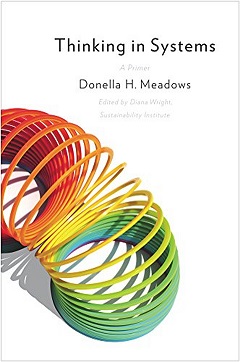What We're Reading Now
Exploring Systems Thinking
18 July 2023
Geof read Thinking in Systems: A Primer, by Donella Meadows. An informational overview of systems thinking and modeling. His blog post attempts to apply some of the principles to a piece of “monumental” folklore.
Tags: geof read
I recently completed Thinking in Systems: A Primer, by Donella Meadows. The book is a comprehensive and valuable overview of systems thinking, including the components of a system, mapping systems, system archetypes, and ways to influence system behavior.
Meadows defines a system as an "interconnected set of elements that is coherently organized in a way that achieves something. If you look at that definition closely for a minute, you can see that a system must consist of three kinds of things: elements, interconnections, and a function or purpose.” Let’s focus on these three elements and compare systems thinking to linear thinking with an anecdote that may be familiar.
Dateline April 17, 1990. From an article about water damage to the Lincoln Memorial in Washington DC in The Spokane Chronicle. “Swarming into the air at dusk for mating, midges (small insects that live along the Potomac River) are attracted by the Lincoln Memorial’s lights and smash into the limestone and marble walls, splattering them with egg masses. The protein remains of the midges attract spiders, which in turn lure sparrows and starlings to the scene. As a result, Park Service crews must give the great marble state of Abraham Lincoln and adjacent walls and floors a daily scrubbing.”
Water, used to scrub midge remains and bird droppings, was seeping into cracks in the monument, and causing considerable long-term damage. As the story goes, the National Park Service experimented postponing illuminating the monuments until after sunset, reducing the number of midges smashing into the monument, and subsequently reducing the spiders, sparrows, droppings, and ultimately the frequency of scrubbing.
This anecdote is often cited as an example of the “five whys technique” for root cause analysis.
- Why was the frequent washing necessary? To clean bird droppings.
- Why were there bird droppings? Because of the number of sparrows and starlings attracted to spiders.
- Why were there spiders? Because spiders were attracted to the population of midges at the monument.
- Why were there so many midges at the monument? Because they were attracted to the lights of the monument, confusing it for the setting sun, and smashing into the monument.
The solution was to turn the lights on after sunset. The National Park Service implemented a six-week pilot program postponing the illumination of the monuments until after sunset. The pilot was a success, with initial data showing an 85% reduction in midge infestation. However, the solution was not implemented. Why? This is a good distinction between linear thinking and systems thinking.
Remember Meadow’s definition of a system: "An interconnected set of elements that is coherently organized in a way that achieves something.” The Lincoln Monument is an element, but elements can be intangible as well according to Meadows. “In a university, school pride and academic prowess are two intangibles that can be very important elements of the system,” along with curriculum, students, staff, buildings, etc.
An important element of the Lincoln Monument (as part of a system of monuments coherently organized in a way to achieve something) was a larger system of tourism. The Lincoln Memorials, perched aside the Potomac River, created an awe-inspiring setting at sunset. The later timing of the lights upset visitors missing the perfect photo of the monument with the sunset across the river. "But tourists who had driven hundreds of miles to have their photographs taken at the monuments were not happy. They complained every day, and the lights went back on, according to a 1995 Chicago Tribune article.”

This is an example of system hierarchy. But let me start with some basics. Meadows describes systems as having some basic parts – stocks and flows.
“A system stock is just what it sounds like: a store, a quantity, an accumulation of material or information that has built up over time.” An example of a stock could be the number of dead midges. It also includes the number of satisfied tourists taking sunset selfies at the Lincoln Memorial. Stocks change over time through the actions of flows.
The National Parks Service can decrease the stock of dead midges by decreasing the flow of light after sunset. This same action can have a negative effect on the stock of happy tourists. Systems thinking allows the National Park Service to map a more holistic model of the world. (In this case, monuments, tourists, and midges.)
This brings us to another important part of systems: feedback loops. “If you see a behavior that persists over time, there is likely a mechanism creating that consistent behavior. That mechanism operates through a feedback loop. It is the consistent behavior pattern over a long period of time that is the first hint of the existence of a feedback loop,” according to Meadows.
Two feedback loops are evident in the midge-monument example. Feedback loop number one, the number of dead midges along the Lincoln Monument is a recurring loop. Recurring feedback loops “generate more input to a stock the more that is already there (and less input the less that is already there). A reinforcing feedback loop enhances whatever direction of change is imposed on it.” The more dead midges, the more spiders, the more sparrows, the more bird droppings, the more necessary cleaning, the more damage.
Feedback loop number two, the number of complaining tourists, is a balancing feedback loop. “Balancing feedback loops are goal-seeking or stability-seeking. Each tries to keep a stock at a given value or within a range of values. A balancing feedback loop opposes whatever direction of change is imposed on the system.” In this case, the system imposed later lighting of the monuments. The stock of upset tourists increased. It increased to the point that the National Park Service stopped the pilot program and returned to lighting the monuments before sunset. (Which in turn increased the number of midges.)

Back to systems hierarchy. Systems can be nested within systems. In this case, the “maintaining the integrity of the monuments” system was nested beneath the “monuments as a tourist destination” system. While postponing the illumination of monuments until after sunset addressed the issues in one system (midge infestation), it created an issue in another system (tourism). By taking a more holistic approach, systems thinking and modeling the feedback loops might have anticipated how the system would react and behave, in this case increased tourist complaints shifting the system away from a viable solution.
Regardless of the stock of dead midges, or the stock of happy tourists, Meadows' book is an inspiring read. I encourage you to think of the stocks, flows, feedback loops, and behaviors you encounter each day.







Comments
Our Comment Policy:
Our blog posts are only half of the conversation. What our readers have to say is equally important to us, and we're grateful for all the comments that continue the dialog.
To ensure that the discussion here is as useful as possible to all of our readers, please be respectful of our contributors and refrain from harassing, threatening and/or vulgar language. We reserve the right to screen and remove any comments from the site. If you have a question about a comment or want to discuss our policy, please contact us. We'll talk it over.
There are no comments for this entry yet.